Septic tanks DKS (MAPLE): device, overview of the model range, advantages and disadvantages
Against the backdrop of numerous options for arranging local sewerage, septic tanks DKS (now KLEN) stand out.The units are affordable and easy to maintain.
To decide whether this solution is suitable for a particular country house or dacha, you will need to get a little closer to the model range of DKS septic tanks, find out the structure and operating principle of the treatment equipment. Our article is devoted to these questions.
In addition, we will talk about the features of installation, operation and maintenance of a septic tank, and outline its strengths and weaknesses. The information provided will help you navigate the variety of models and choose the best option for arranging a local sewer system.
The content of the article:
How to choose a suitable septic tank?
To ensure your family a comfortable stay at the dacha, you will have to resolve the issue of sewerage installation. After all, without the usual sink and shower, it’s difficult to enjoy being outdoors on hot summer days.
This is especially important if there is a child in the family. Therefore, you will need a septic tank that can cope with the corresponding level of load.
Model range of septic tanks DKS
The company "Dachny Sewerage Systems" (abbreviated as DKS) has developed several options for arranging autonomous waste disposal outside the city.
Solutions differ in tank volume, functions performed and cost. To find your ideal septic tank from this manufacturer, you will have to familiarize yourself with the main offers.
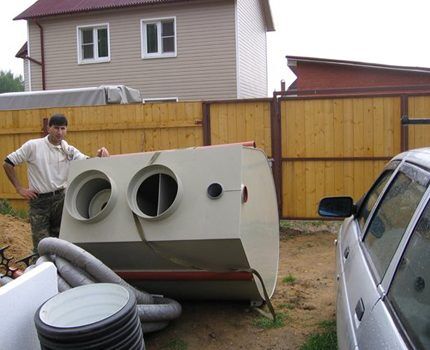
Treatment facilities are represented by two series, fundamentally different in their capabilities:
- DKS series, now MAPLE, including septic tanks;
- MBO series, including KLEN deep cleaning stations, now designated by the letter N.
The first option includes simpler equipment that can serve as a conventional septic tank. The second option is real biological treatment stations.

Optimum – This is the company’s most compact installation. It is designed for 3-4 people who use the cottage periodically. If you plan to stay permanently, then the equipment can withstand the load of waste disposal from 1-2 people.
In this case, the total volume of liquid should not exceed 250 liters. The Optimum model is not capable of withstanding a volley discharge of water after taking a bath.
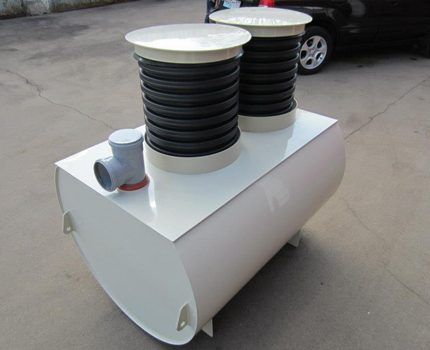
The dimensions of this mini septic tank are very compact - up to 1 m in height and width and up to 1.2 m in length. Its weight is no more than 35 kg. Moreover, it is possible to buy equipment both in the basic configuration and to purchase additional neck extensions and a pump, if required in a particular case.
The most popular model, capable of handling wastewater with a volume of 450 liters per day, is DKS 15. It exists in a modification with the letter “M” - DKS 15M, which means the possibility of installation in areas with high groundwater levels. It can be installed in the ground to a depth of 1 meter to ensure high-quality work in the cold season.
The weight of this model is about 50 kg, and the dimensions are up to 1.3 m in width and height, 1.5 m in length. It is convenient for small families who prefer to take a bath every day, or for 3-4 cottage residents who use water sparingly when living permanently.
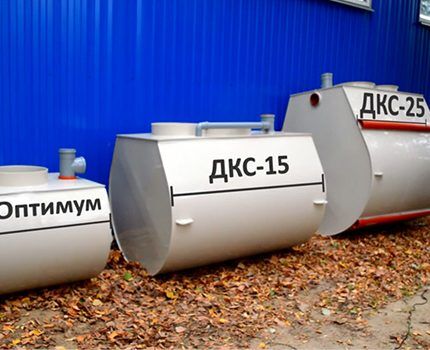
If the family is large, and relatives and friends like to visit often and stay for 2-3 weeks, then you should pay attention to the model DKS 25 And DKS 25 M. All modifications of the manufacturer with the M prefix are for high groundwater levels.
This option is capable of coping with a volley discharge after draining the water from the bathtub, and other types of wastewater with a total volume of up to 800 liters in one day, which corresponds to the needs of 4-5 people permanently residing in the house.
The weight of the container is within 70 kg, and the dimensions are 1.3 m in height and 1.5 m in width and length. Such dimensions allow you to transport the equipment on your own and, with the help of a friend or neighbor, complete installation. There is no need to involve special equipment.
Specification of sewerage stations
In addition to a series of septic tanks, the company has developed a line of local treatment facilities capable of biological wastewater treatment.
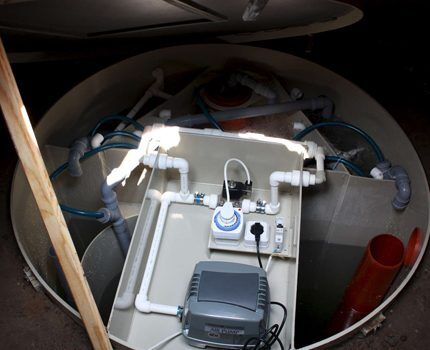
The number in the model name indicates the station's productivity in cubic meters. So, MBO-0.75 capable of handling wastewater with a volume of 0.75 m33 per day. This meets the needs of a family of 4.
The most interesting thing is that the station will withstand periodic raids by relatives. Its height is up to 2 m, and its diameter is up to 0.9 m. The weight in the basic configuration reaches 80 kg.

Models of sewer stations are most often purchased for dachas and country houses with a total of 5-8 inhabitants. They are capable of withstanding salvo discharge and other wastewater with a daily volume of 1 m33 and 1.5 m3 respectively. The weight of the containers is 92 and 110 kg, and the height is up to 2 meters.
If installation is necessary in conditions of high groundwater levels, you can choose a modification with a built-in pump.
Stations of the model range with digital designations 2-5 are purchased much less frequently. They are intended for cottages, mini-hotels and other buildings with daily water consumption from 2 to 5 m3.
Moreover, the manufacturer has provided the opportunity to select the desired option with a built-in pump at a high groundwater level. The cost of such a solution will be slightly higher than the standard option.
Features of the use of various models
Models of the DKS series with the letter “M”, equipped with a pump for high groundwater levels, are energy-dependent. Also, for the operation of all sewer stations, as well as for modifications with a built-in pump, electricity is required. This is something to consider when choosing your ideal option.
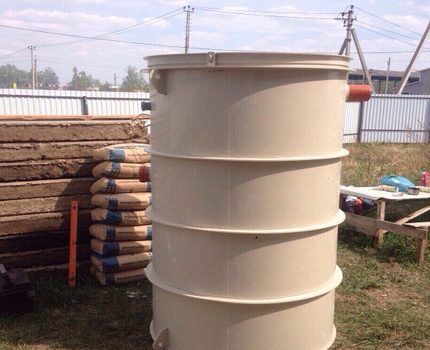
In addition to dependence on electricity, it is necessary to take into account the operating features of various septic tank models.
Firstly, biological treatment stations are extremely ineffective in conditions of rare visits to the dacha/house. No matter how much you would like to acquire high-quality equipment with a high degree of purification, you will have to refuse this option.
Secondly, by choosing an option with insufficient volume, you can significantly ruin your country life - the equipment will not be able to cope with the load and untreated wastewater will end up in the ground.
Third, you should take into account the characteristics of your site. In some regions, ground movement is observed in spring. If there is such activity in the planned location of the septic tank, under no circumstances should concreting be done. When the ground moves and the pressure of the concrete, the plastic container can be crushed.
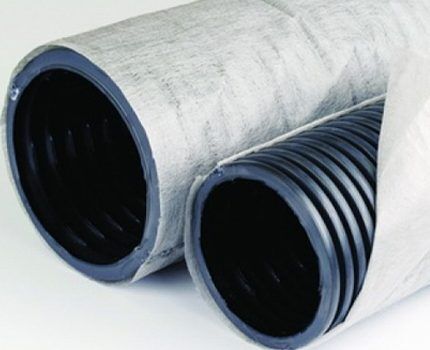
Fourth, in the technical characteristics of each model, the manufacturer provides the maximum permissible immersion depth in a dug pit. These numbers should not be ignored - violation of installation rules can lead to the destruction of the septic tank under the influence of the gravity of the soil piled on top.
Design and principle of operation
KLEN treatment equipment can be used in everyday life to collect and treat wastewater entering an installed container through a sewer pipe.
The design and operating principle of the models depends on the series of equipment. The company produces all septic tanks from high quality polypropylene.The wall thickness of the finished containers ranges from 5-8 mm, and all seams are made by hand.
Structural diagram
The model range of the MAPLE series has a common structure. These septic tanks consist of primary and secondary settling chambers and a chamber with a biofilter.
On the side of the first tank there is a hole for connecting sewer pipe, through which waste flows into it, and on the other side there is a hole for a pipe that discharges the purified liquid. This is inherent in models with gravity drainage.
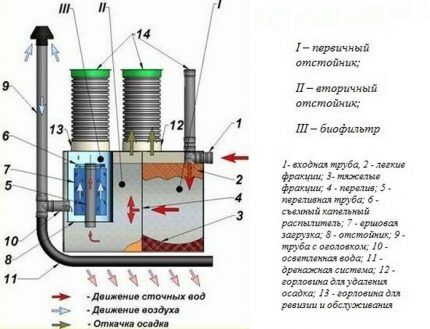
The septic tank is also equipped with openings for inspection, gas removal and clean air supply. All technical holes are equipped with polypropylene necks, which protrude above the ground after installation. Also, some models are equipped with a drainage pump to drain purified water into the drainage system.
If we are talking about Klen septic tanks, then there is a simpler design, and sewer stations have more complex structural components. But the degree of purification of sewage wastewater at the outlet in the second case can reach the level of technical water.
Models of a biological treatment station consist of the following compartments:
- settling tank;
- denitrifier;
- aeration tank;
- desilter;
- post-treatment unit;
- disinfectant at the exit.
The stations are equipped with airlifts, inlet and outlet pipes, an aerator and a brush loading. They require electricity to operate.
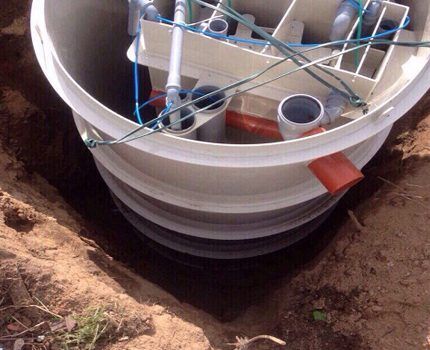
Operating principle of wastewater treatment plants
In septic equipment of the DKS series, the treatment of incoming wastewater begins in the very first compartment, called the settling tank. Here, heavy and light particles fall down and rise up, respectively. The middle part of the dirty liquid, freed from these fractions, flows into the second tank.
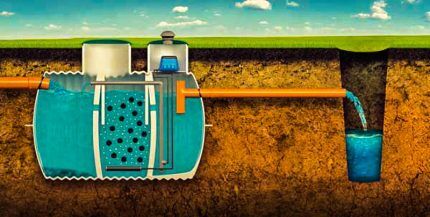
The second settling tank allows small particles still contained in the turbid water to sink to the bottom. All factions that find themselves at the bottom fall under exposure to bacteria anaerobes. These methanogenic microorganisms live and work without oxygen. They turn waste into sludge that remains at the bottom.
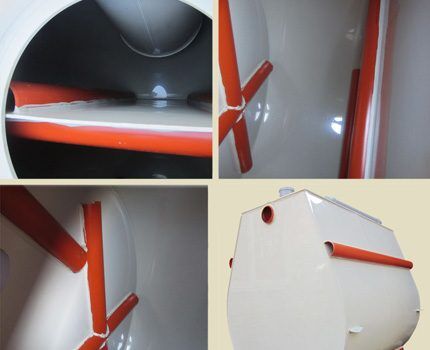
Then the liquid enters the 3rd compartment, equipped with a biofilter with brush loading. Here, additional purification processes occur through the formation of a favorable environment for aerobes. Oxygen for their existence is supplied through a special pipe with a head.
Aerobes perform additional treatment of wastewater before removing it from the tank. Although the liquid flowing out of the outlet pipe is clarified, it requires additional cleaning. To do this, it is sent to the drainage system - filter field or filtration well.
Operating principle of the series models DKS-MBO provides for complete cleaning and disinfection of wastewater in the equipment itself.The wastewater, entering the first chamber, begins to pass through all the compartments, where it undergoes purification processes, ranging from mechanical to biological.
The liquid leaving the container has the state of technical water, which can be used for irrigation.
Another feature in the operation of DKS-MBO stations is the presence of two technological stages of operation:
- first – performing functions for processing, cleaning and disposal of incoming sewage waste;
- second – removal of dying sludge from the output cascades.
The last stage is called buildup. This happens at night, when the system is resting from the flow of dirty liquid or its amount is minimal.
The station starts an automatic pumping mode of the denitrifier in order to move water from the post-treatment compartment with a high content of dead sludge into the primary settling chamber.
All septic tanks from the DKS company require minimal participation from the owner. Daily monitoring and intervention in their work is not required. Periodically, it is necessary to inspect the operation of all components of the system and clean the filtration components.

To remove sludge, it is enough to call a sewer truck once every two years. These works can also be easily done on your own using fecal pump. The pumped out sludge can be placed in a compost pit for later use as fertilizer.
The rules for maintaining a septic tank in winter are described in detail in this article.
Pros and cons of BCS installations (KLEN)
DKS treatment systems have their positive and negative sides. According to the testimony of summer residents who have been using the installations for many years, many of them are very satisfied with this solution to the issue of individual sewerage for their dachas. Especially if the model is chosen correctly.
Advantages of these septic tanks
You can hear about the undoubted advantages and disadvantages of DKS septic tanks, which are popular among summer residents, from the lips of the users themselves. All the praises of some clients and the complaints of others can be summarized by highlighting the main characteristics.
Particularly noteworthy are the positive qualities, which are expressed in the following:
- various models;
- affordable price;
- ease of delivery and installation;
- light weight;
- safety;
- practicality;
- availability of non-volatile models.
- simple maintenance.
The model range allows you to choose the solution that is most suitable in a particular case. After all, there are very small dachas whose owners do not have the opportunity to pay for expensive individual sewerage projects.
And there is no point in this when they use the dacha for a couple of summer months. For such cases, the manufacturer has provided a suitable option in terms of cost and performance - Optimum.
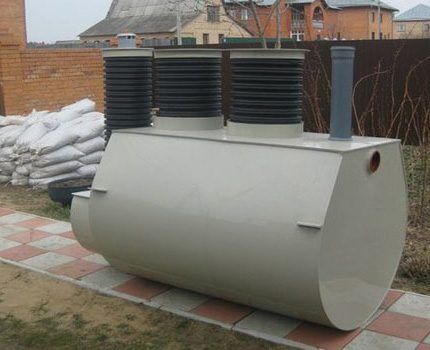
The low weight due to the properties of polypropylene allows the owner to independently deliver the septic tank to the installation site.
Thanks to its compact size, you can do without outside help when loading and unloading, especially if you purchased one of the models weighing up to 52 kg. What can't be said about significant weight? septic tank made of concrete rings.
The company that produces septic tanks with the same name, DKS, has quality certificates and all the necessary documentation confirming the safety of using its products. High-quality raw materials used for the manufacture of sewer tanks allow us to provide a guarantee for their use for 40 years or more.
Dependence on electricity is one of the key issues for many summer residents. BCS manufacturers took this issue into account by offering their customers a number of non-volatile installations. This has become a real godsend for summer residents who do not have backup power sources.
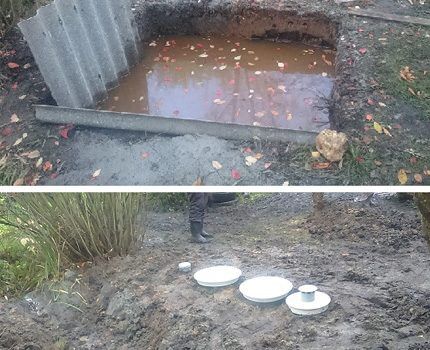
Ease of maintenance lies in the need to get rid of sludge once every 2 years. You can do this yourself or call a sewer truck.
To prepare equipment for winter, you do not need to carry out any manipulations. These factors greatly simplify the use of installations.
Negative sides
In addition to the positive aspects of DKS septic tanks, a number of disadvantages can be identified.
Among them:
- ground movements can crush the hull;
- demands on the installation site;
- compliance with installation rules;
- it is impossible to increase the volume of the septic tank.
If the soil at the dacha has a predisposition to seasonal movements, then the walls of the septic tank may not withstand such pressure.
This nuance should be taken into account when choosing the most suitable septic tank option for your site. Indeed, in DKS models, despite the presence of stiffeners, the wall thickness ranges from 5 to 8 mm.
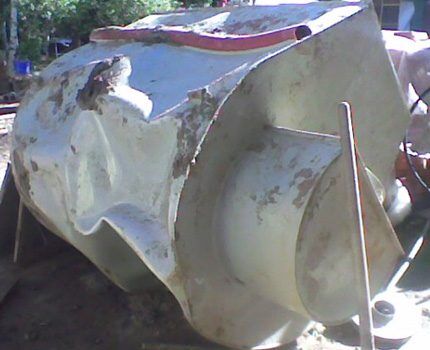
As for the installation location, it is important to choose one so that the sewer truck can freely approach the equipment if necessary to carry out pumping work.
This issue must be resolved before installing the septic tank. Also, a drainage system should be installed for additional purification of the liquid that has been clarified in the septic tank.
If the installation is carried out on your own, then you need to adhere to the rules for placing the sewerage installation at a sufficient distance from the well and other sources of drinking water.
When it is planned to involve specialists in this work, the owner will not have to worry about anything - they themselves will select the most suitable place for installation.
Another drawback is the inability to increase the useful volume of the container by attaching or purchasing an additional chamber. This question is relevant when, a couple of years after installation, the composition of the family has changed significantly and the septic tank is no longer able to cope with the volume of wastewater.
In this case, it is better to immediately choose a new option, taking into account the possible increase in the number of family members in the next 3-5 years.

If you still haven’t decided on a septic tank for your dacha, we recommend that you read the following articles:
- How to choose a septic tank for your dacha: review and tips for choosing the best option
- Budget septic tanks for a summer residence without pumping: the best manufacturers of septic tanks without pumping on the market
- Septic tank for high groundwater: methods for determining groundwater level and recommendations for choosing a septic tank
Conclusions and useful video on the topic
Video clip about immersing the installation into a pit:
Detailed video about installing a drainage pump in a septic tank:
After familiarizing yourself with the operating principle and design of DCS septic tanks, you can choose the model that is most suitable for a particular situation.
A variety of options will allow you not to overpay for a biological treatment station and get optimal local sewerage.Moreover, the cost of the BCS equipment compares favorably with the ratio of price and quality.
If you have experience installing and operating a DKS septic tank, please share the information with our readers. Leave comments and reviews about cleaning equipment, ask questions and participate in discussions. The contact form is below.
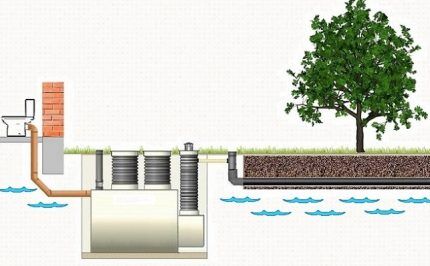




Greetings to all readers of this resource. My name is Deyanov Alexander Vladimirovich.
Since 2006, I have been an employee of DKS LLC (the official manufacturer of DKS septic tanks). I declare with full responsibility that our company has never renamed the septic tank “DKS” to the septic tank “Klen”. This was forced to do by our unscrupulous “partners,” as they now say, who launched the production of septic tanks using a makeshift method under our brand. But we forced them to change their name by publishing a video exposing them on our website. As for the compressed septic tank in the photo, this is exactly the same replica, because... the original does not have an external storage device (such as an extension on the side). But we were aware of the incident and we were interested in establishing the cause of the breakdown. As it turned out, the cause of the compression was not mobile soil or its concreting, but the negligence of the user, who, having pumped out the septic tank (once every three years according to the regulations), did not fill the septic tank back with water, but left it empty for a long period of time, which became the cause of the deformation . If anyone has questions, here is my personal number 8-916-400-48-60.
Thanks for the warning. I’m currently looking at your septic tank, reading reviews, etc. Now everything is clear with this confusion with names.